Symphyotrichum 'Prairie Purple'
aster 'Prairie Purple'
A clump-forming herbaceous perennial to about 1m with dark green stems and foliage, flushed with dark purple. Light purple flowers with yellow to dark red centres open from late summer to late autumn
Size
Ultimate height
1–1.5 metresTime to ultimate height
2–5 yearsUltimate spread
0.1–0.5 metresGrowing conditions
Moisture
Moist but well–drainedpH
Acid, Alkaline, NeutralColour & scent
| Stem | Flower | Foliage | Fruit | |
| Spring | Green Purple | Green Purple | ||
|---|---|---|---|---|
| Summer | Green Purple | Purple | Green Purple | |
| Autumn | Green Purple | Purple | Green Purple | |
| Winter |
Position
- Full sun
- Partial shade
Aspect
South–facing or West–facing or East–facing or North–facing
Exposure
Exposed or Sheltered Hardiness
H7Botanical details
- Family
- Asteraceae
- Native to GB / Ireland
- No
- Foliage
- Deciduous
- Habit
- Clump forming
- Genus
Symphyotrichum includes around 90 species of annuals, biennials and perennials, mostly spread through the Americas, that were formerly included within the genus Aster. Leaves are simple, lance-shaped and entire, but it is their daisy-like flowerheads that they are grown for; central disc florets are typically yellow, surrounded by strap-shaped ray florets in shades of pink, blue, purple or white
- Name status
Accepted
How to grow
Cultivation
Grow in rich, fertile, moisture-retentive soil, in full sun if the soil remains moist throughout the growing season, or in partial shade; mulch every year after cutting down in late autumn. Divide every third year to retain vigour and flower quality. May require support - see staking perennials
Propagation
Propagate by division in spring, replanting only vigorous young shoots
Suggested planting locations and garden types
- City and courtyard gardens
- Cottage and informal garden
- Coastal
- Gravel garden
- Prairie planting
- Wildlife gardens
- Cut flowers
- Flower borders and beds
Pruning
Cut back close to the ground in late autumn
Pests
Diseases
May be susceptible to Fusarium foot rot, leaf spot, grey moulds and Verticillium wilt. Has some resistance to powdery mildews
Get involved
The Royal Horticultural Society is the UK’s leading gardening charity. We aim to enrich everyone’s life through plants, and make the UK a greener and more beautiful place.
